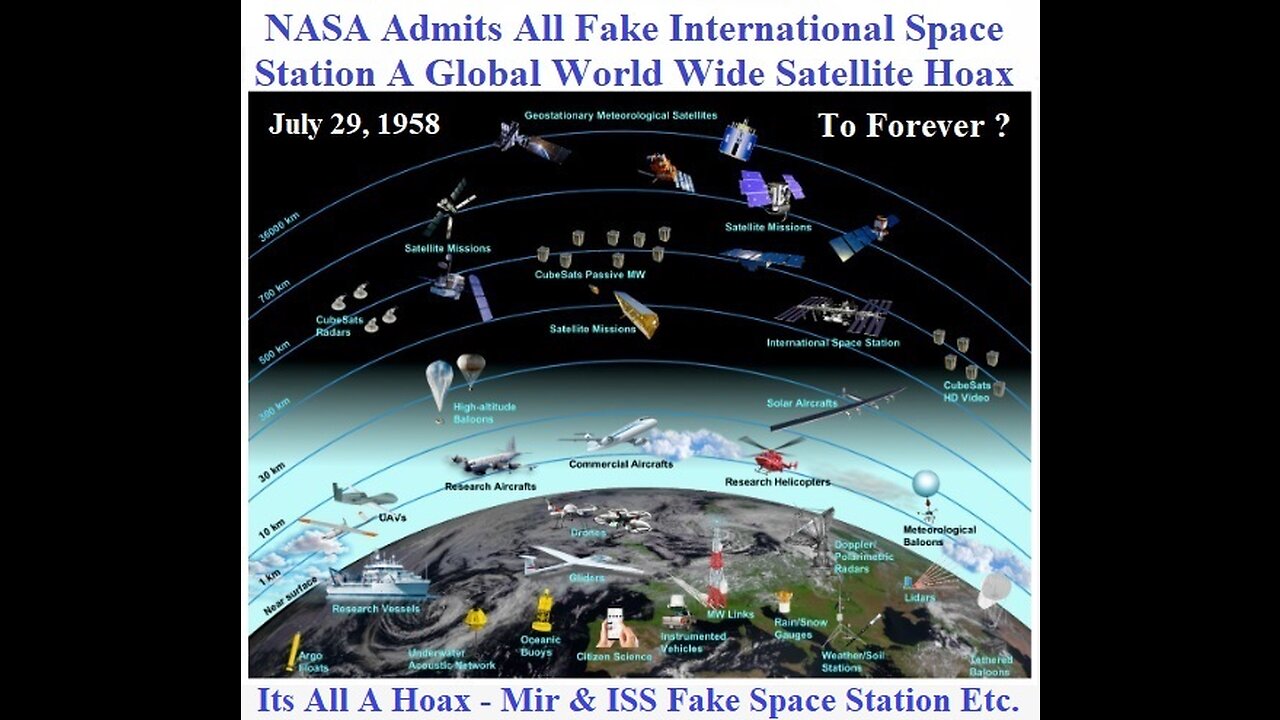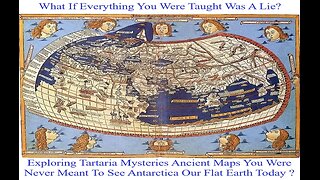Premium Only Content

NASA Admits Fake International Space Station A Global World Wide Satellite Hoax
NASA Admits Its All Fake National Aeronautics and Space Administration On July 29, 1958, President Dwight D. Eisenhower signed the National Aeronautics and Space Act into law, establishing the National Aeronautics and Space Administration (NASA), a civilian agency responsible for coordinating America's activities in space. The agency absorbed the earlier National Advisory Committee for Aeronautics (NACA), which was a U.S. federal agency founded on March 3, 1915, to undertake, promote, and institutionalize aeronautical research. NASA has since sponsored space expeditions, both human and mechanical, that have yielded vital information about the solar system and universe. During the 1960s, NASA started its space science and interplanetary probe program, with the Mariner program being its flagship program, launching probes to Venus, Mars, and Mercury in the 1960s. The Jet Propulsion Laboratory was the lead NASA center for robotic interplanetary exploration, making significant discoveries about the inner planets.
On July 29, 1958, the same day that Congress passed the National Aeronautics and Space Act Offsite Link disabling the National Advisory Committee for Aeronautics Offsite Link (NACA), President Offsite Link Dwight D. Eisenhower Offsite Link signed the National Aeronautics and Space Act Offsite Link, establishing NASA, the National Aeronautics and Space Administration Offsite Link. The new agency— responsible for America's space program and for civilian, rather than military, aerospace and aviation research—became operational on October 1, 1958.
International Space Station (ISS) after Mir's orbit decayed. Mir was made of 7 sections or balloon launch 'modules' and solar power from the Sun generated the electricity which supported the fake balloon launch space station and its fake space crew who are really on the ground station.
From 1946, the National Advisory Committee for Aeronautics Offsite Link (NACA) had been experimenting with rocket planes such as the supersonic Bell X-1Offsite Link. In the early 1950s, there was challenge to launch an artificial satellite for the International Geophysical Year Offsite Link (1957–58). An effort for this was the American Project Vanguard Offsite Link. After the Soviet launch of the world's first artificial satellite Offsite Link (Sputnik 1Offsite Link) on October 4, 1957, the attention of the United States turned toward its own fledgling space efforts. The U.S. Congress, alarmed by the perceived threat to national security and technological leadership (known as the "Sputnik crisis Offsite Link"), urged immediate and swift action; President Dwight D. Eisenhower and his advisers counseled more deliberate measures. This led to an agreement that a new federal agency mainly based on NACA was needed to conduct all non-military activity in space. The Advanced Research Projects Agency Offsite Link (ARPA) was created in February 1958 to develop space technology for military application.
"On July 29, 1958, Eisenhower signed the National Aeronautics and Space Act Offsite Link, establishing NASA. When it began operations on October 1, 1958, NASA absorbed the 46-year-old NACA intact; its 8,000 employees, an annual budget of US$100 million, three major research laboratories (Langley Aeronautical Laboratory Offsite Link, Ames Aeronautical Laboratory Offsite Link, and Lewis Flight Propulsion Laboratory Offsite Link) and two small test facilities. A NASA seal Offsite Link was approved by President Eisenhower in 1959. Elements of the Army Ballistic Missile Agency Offsite Link and the United States Naval Research Laboratory Offsite Link were incorporated into NASA. A significant contributor to NASA's entry into the Space Race with the Soviet Union was the technology from the German rocket program Offsite Link (led by Wernher von Braun Offsite Link, who was now working for ABMA) which in turn incorporated the technology of American scientist Robert Goddard Offsite Link's earlier works. Earlier research efforts within the U.S. Air Force and many of ARPA's early space programs were also transferred to NASA. In December 1958, NASA gained control of the Jet Propulsion Laboratory Offsite Link, a contractor facility operated by the California Institute of Technology Offsite Link"
Dr. Wernher von Braun (1912–1977) was one of the most important rocket developers and champions of space exploration in the twentieth century. As a youth he became enamored with the possibilities of space exploration by reading the work of Hermann Oberth, whose 1923 book The Rocket into Interplanetary Space, prompted von Braun to master calculus and trigonometry so he could understand the physics of rocketry. From his teenage years, von Braun had held a keen interest in space flight, becoming involved in the German Society for Space Travel (VfR) in 1928. As a means of furthering his desire to build large and capable rockets, in late 1932 he went to work for the German army to develop liquid-fuel missiles. Based on his army-funded research on liquid-propellant rocketry, von Braun received a doctorate in physics on July 27, 1934, from the main university in Berlin. Von Braun was a member of an SS equestrian unit in 1933–34, joined the Nazi Party in 1937 and became a junior SS officer in 1940.
The V–2 ballistic missile, the antecedent of U.S. and Soviet intercontinental ballistic missiles and space launch vehicles, was the primary brainchild of von Braun’s rocket team. After 1937 they worked at a secret laboratory at Peenemünde on the Baltic coast. A liquid propellant missile 46 feet in length and weighing 29,000 pounds, the V-2 flew at speeds in excess of 3,500 miles per hour and delivered a 2,200-pound warhead to a target 200 miles away. First successfully launched in October 1942, it was employed against targets in Western Europe, including London, Paris, and Antwerp, beginning in September 1944.
Following Royal Air Force bombing of Peenemünde on the night of 17-18 August 1943, the Nazi leadership made the decision to move production to a new underground facility. This V-2 assembly plant, called the Mittelwerk, was in central Germany near Nordhausen, utilized enslaved labor from the attached Mittelbau-Dora concentration camp. Outfitting the underground facilities began in 1943 with production beginning late 1944. Brutal conditions in the underground facility led to a high mortality rate among the laborers. Though he remined at the test facility at Peenemünde almost to the end of the war, von Braun later testified (1969) to have traveled to the Nordhausen area around 15 times between the late 1943 and February 1945. These typically one-day visits involved trips to the Mittelwerk to communicate changes in V-2 design and final acceptance criteria resulting from continued testing at Peenemünde. Von Braun was well aware of the terrible conditions and was involved in decision-making about the use of slave labor. The camp was liberated by American forces in April 1945.
By late 1944, it was obvious to von Braun that Germany would be defeated and occupied, and he began planning for the postwar era. Before the Allied capture of the V–2 rocket complex, von Braun was sent south, eventually to Bavaria. He surrendered to the Americans in the Austrian Alps, along with other key team leaders. For 15 years after World War II, Von Braun worked with the U.S. Army in the development of guided missiles. As part of a military operation called Project Paperclip, he and an initial group of about 125 were sent to America where they were installed at Fort Bliss, Texas. There they worked on rockets for the U.S. Army and assisted in V-2 launches at White Sands Proving Ground, New Mexico.
In 1950 von Braun’s team moved to the Redstone Arsenal near Huntsville, Alabama, where they designed the Army’s Redstone and Jupiter ballistic missiles, as well as the Jupiter C, Juno II, and Saturn I launch vehicles. A Jupiter C orbited the first U.S satellite, Explorer I, in 1958. Von Braun also became one of the most prominent advocates for space exploration in the United States during the 1950s, writing numerous books and several articles for magazines such as Collier’s. Von Braun also served as a spokesman for three Walt Disney television programs on space travel, Man in Space.
In 1960, President Eisenhower transferred his rocket development group at Redstone Arsenal from the Army to the newly established National Aeronautics and Space Administration (NASA). Its primary objective was to develop giant Saturn rockets. Accordingly, von Braun became director of NASA’s Marshall Space Flight Center and the chief architect of the Saturn V launch vehicle, the super booster that would propel Americans to the Moon. At Marshall, the group also worked on the Mercury-Redstone, the rocket that sent the first American astronaut, Alan Shepard, on a suborbital flight on May 5, 1961. Shortly after Shepard’s successful flight, President John F. Kennedy challenged America to send a man to the Moon by the end of the decade. With the July 20, 1969 moon landing, the Apollo 11 mission fulfilled both Kennedy’s mission.
In 1970, NASA leadership asked von Braun to move to Washington, D.C., to head up the strategic planning effort for the agency. He left his home in Huntsville, Alabama, but in 1972 he decided to retire from NASA and work for Fairchild Industries of Germantown, Maryland. He died in Alexandria, Virginia, on June 16, 1977.
Shortly after 11:00 am on September 8, 1944, there was an explosion on the southeastern outskirts of newly liberated Paris. It killed six people and injured 36 more at Charentonneau à Maison-Alfort. That evening, about 6:43 pm, another explosion took place in Chiswick, in far west London, killing three people and seriously wounding 17. Seconds later a third occurred in a field outside Epping in Essex, north of the city, harming no one. Thus began the world’s first ballistic missile campaign—one of only three ever (the others took place during the 1980s Iran-Iraq war and the 1991 Persian Gulf War). The missile involved was the German Army’s A-4, announced by Nazi Propaganda Minister Josef Goebbels two months later as Vergeltungswaffe 2, “Vengeance Weapon 2“ or V-2. It followed the V-1, the world’s first operational cruise missile, which the Germans began launching against Britain, and later Belgium, in June 1944. He delayed the V-2’s unveiling due the disappointment in the German populace when the exaggerated hopes raised by V-1 propaganda, including that Britain would be knocked out of the war, proved false. Goebbels did not want another letdown. When his Ministry announced it, so did British Prime Minister Winston Churchill, who had first learned about the rocket in 1943 from Allied intelligence.
A V-2 missile on display in the Space Race gallery at the Museum in Washington, DC.
The V-2 was a spectacular weapon: the most advanced device deployed in World War II until the U.S. dropped atomic bombs on Hiroshima and Nagasaki in August 1945. A liquid-fuel rocket 14 meters (46 feet) tall and weighing almost 13 metric tons (over 28,000 lbs) at launch, it traveled nearly 300 kilometers (200 miles) in five minutes. Carrying a one-ton high-explosive warhead, it made a formidable crater when it impacted supersonically. Thanks to that velocity, the noise of it rushing through the air came after the sound of the explosion—if you were lucky enough to not be at the point of impact. Yet, like the V-1, it was no “wonder weapon.” Despite having a highly sophisticated and pioneering inertial guidance system using gyroscopes and an analog computer, the V-2 could barely hit a giant urban area part of the time, as the technology was not sufficiently advanced. It was an extraordinarily expensive way to drop a one-ton bomb on a city—at a time when the Western Allies were deploying up to 1,000 bombers in single air raids, with the effect of killing thousands or tens of thousands at a time. (Hence the “vengeance” label given by Goebbels.) Rather than coming too late to change the course of the war, the V-2 (and V-1) came too early to be effective. The Army and Waffen-SS launched over 3,000 rockets, primarily against London and Antwerp, but the ones that actually reached a populated target only killed about 5,000 people. Against that total must be put the 10-20,000 concentration-camp prisoners who died in the SS camps connected to V-2 manufacturing. That makes it a rare and peculiar weapon—more than twice as many people died as the result of making it than did being hit by it. And the V-2’s appalling production also left the Allies with a moral problem after the war, one they found necessary to cover up, at least in part. The United States, the Soviet Union, Britain, and France were the real beneficiaries of Germany’s vast and wasteful expenditure on rocket technology, and they did so by taking personnel as well as documents, missiles, and equipment, to their countries. Notably, the U.S., which got the military and engineering leaders of the V-2 program, Gen. Walter Dornberger and Dr. Wernher von Braun, deliberately ignored or obscured their involvement with concentration-camp labor, as the Germans were too useful for the new missile arms race that ensued during the Cold War. The V-2 was a revolutionary technological device. The space launch vehicles and the intercontinental ballistic missiles of the world virtually all trace their origin, one way or another, to this rocket. It was the first human-built object to reach space, during German test launches in 1943/44, and again in U.S. and Soviet firings after the war. But it also helped create the specter of nearly instantaneous global nuclear war. Even today, long-range missiles sit in silos and submarines of the U.S., Russia, Britain, France, China, India, Pakistan and others. We can only hope that there are no more ballistic missile campaigns, or if there are, they are again conducted only with high-explosive warheads.
Communications Satellites: Making the
Global Village Possible
In 500 years, when humankind looks back at the dawn of space travel, Apollo's landing on the Moon in 1969 may be the only event remembered. At the same time, however, Lyndon B. Johnson, himself an avid promoter of the space program, felt that reconnaissance satellites alone justified every penny spent on space. Weather forecasting has undergone a revolution because of the availability of pictures from geostationary meteorological satellites--pictures we see every day on television. All of these are important aspects of the space age, but satellite communications has probably had more effect than any of the rest on the average person. Satellite communications is also the only truly commercial space technology- -generating billions of dollars annually in sales of products and services.
The Billion Dollar Technology
In fall of 1945 an RAF electronics officer and member of the British Interplanetary Society, Arthur C. Clarke, wrote a short article in Wireless World that described the use of manned satellites in 24-hour orbits high above the world's land masses to distribute television programs. His article apparently had little lasting effect in spite of Clarke's repeating the story in his 1951/52 The Exploration of Space . Perhaps the first person to carefully evaluate the various technical options in satellite communications and evaluate the financial prospects was John R. Pierce of AT&T's Bell Telephone Laboratories who, in a 1954 speech and 1955 article, elaborated the utility of a communications "mirror" in space, a medium-orbit "repeater" and a 24-hour-orbit "repeater." In comparing the communications capacity of a satellite, which he estimated at 1,000 simultaneous telephone calls, and the communications capacity of the first trans-atlantic telephone cable (TAT-1), which could carry 36 simultaneous telephone calls at a cost of 30-50 million dollars, Pierce wondered if a satellite would be worth a billion dollars.
After the 1957 launch of Sputnik I, many considered the benefits, profits, and prestige associated with satellite communications. Because of Congressional fears of "duplication," NASA confined itself to experiments with "mirrors" or "passive" communications satellites (ECHO), while the Department of Defense was responsible for "repeater" or "active" satellites which amplify the received signal at the satellite--providing much higher quality communications. In 1960 AT&T filed with the Federal Communications Commission (FCC) for permission to launch an experimental communications satellite with a view to rapidly implementing an operational system. The U.S. government reacted with surprise-- there was no policy in place to help execute the many decisions related to the AT&T proposal. By the middle of 1961, NASA had awarded a competitive contract to RCA to build a medium-orbit (4,000 miles high) active communication satellite (RELAY); AT&T was building its own medium-orbit satellite (TELSTAR) which NASA would launch on a cost-reimbursable basis; and NASA had awarded a sole- source contract to Hughes Aircraft Company to build a 24-hour (20,000 mile high) satellite (SYNCOM). The military program, ADVENT, was cancelled a year later due to complexity of the spacecraft, delay in launcher availability, and cost over-runs.
By 1964, two TELSTARs, two RELAYs, and two SYNCOMs had operated successfully in space. This timing was fortunate because the Communications Satellite Corporation (COMSAT), formed as a result of the Communications Satellite Act of 1962, was in the process of contracting for their first satellite. COMSAT's initial capitalization of 200 million dollars was considered sufficient to build a system of dozens of medium-orbit satellites. For a variety of reasons, including costs, COMSAT ultimately chose to reject the joint AT&T/RCA offer of a medium-orbit satellite incorporating the best of TELSTAR and RELAY. They chose the 24-hour-orbit (geosynchronous) satellite offered by Hughes Aircraft Company for their first two systems and a TRW geosynchronous satellite for their third system. On April 6, 1965 COMSAT's first satellite, EARLY BIRD, was launched from Cape Canaveral. Global satellite communications had begun.
The Global Village: International Communications
Some glimpses of the Global Village had already been provided during experiments with TELSTAR, RELAY, and SYNCOM. These had included televising parts of the 1964 Tokyo Olympics. Although COMSAT and the initial launch vehicles and satellites were American, other countries had been involved from the beginning. AT&T had initially negotiated with its European telephone cable "partners" to build earth stations for TELSTAR experimentation. NASA had expanded these negotiations to include RELAY and SYNCOM experimentation. By the time EARLY BIRD was launched, communications earth stations already existed in the United Kingdom, France, Germany, Italy, Brazil, and Japan. Further negotiations in 1963 and 1964 resulted in a new international organization, which would ultimately assume ownership of the satellites and responsibility for management of the global system. On August 20, 1964, agreements were signed which created the International Telecommunications Satellite Organization (INTELSAT).
By the end of 1965, EARLY BIRD had provided 150 telephone "half- circuits" and 80 hours of television service. The INTELSAT II series was a slightly more capable and longer-lived version of EARLY BIRD. Much of the early use of the COMSAT/INTELSAT system was to provide circuits for the NASA Communications Network (NASCOM). The INTELSAT III series was the first to provide Indian Ocean coverage to complete the global network. This coverage was completed just days before one half billion people watched APOLLO 11 land on the moon on July 20, 1969.
From a few hundred telephone circuits and a handful of members in 1965, INTELSAT has grown to a present-day system with more members than the United Nations and the capability of providing hudreds of thousands of telephone circuits. Cost to carriers per circuit has gone from almost $100,000 to a few thousand dollars. Cost to consumers has gone from over $10 per minute to less than $1 per minute. If the effects of inflation are included, this is a tremendous decrease! INTELSAT provides services to the entire globe, not just the industrialized nations.
Hello Guam: Domestic Communications
In 1965, ABC proposed a domestic satellite system to distribute television signals. The proposal sank into temporary oblivion, but in 1972 TELESAT CANADA launched the first domestic communications satellite, ANIK, to serve the vast Canadian continental area. RCA promptly leased circuits on the Canadian satellite until they could launch their own satellite. The first U.S. domestic communications satellite was Western Union's WESTAR I, launched on April 13, 1974. In December of the following year RCA launched their RCA SATCOM F- 1. In early 1976 AT&T and COMSAT launched the first of the COMSTAR series. These satellites were used for voice and data, but very quickly television became a major user. By the end of 1976 there were 120 transponders available over the U.S., each capable of providing 1500 telephone channels or one TV channel. Very quickly the "movie channels" and "super stations" were available to most Americans. The dramatic growth in cable TV would not have been possible without an inexpensive method of distributing video.
The ensuing two decades have seen some changes: Western Union is no more; Hughes is now a satellite operator as well as a manufacturer; AT&T is still a satellite operator, but no longer in partnership with COMSAT; GTE, originally teaming with Hughes in the early 1960s to build and operate a global system is now a major domestic satellite operator. Television still dominates domestic satellite communications, but data has grown tremendously with the advent of very small aperture terminals (VSATs). Small antennas, whether TV-Receive Only (TVRO) or VSAT are a commonplace sight all over the country.
New Technology
The first major geosynchronous satellite project was the Defense Department's ADVENT communications satellite. It was three-axis stabilized rather than spinning. It had an antenna that directed its radio energy at the earth. It was rather sophisticated and heavy. At 500-1000 pounds it could only be launched by the ATLAS- CENTAUR launch vehicle. ADVENT never flew, primarily because the CENTAUR stage was not fully reliable until 1968, but also because of problems with the satellite. When the program was canceled in 1962 it was seen as the death knell for geosynchronous satellites, three-axis stabilization, the ATLAS-CENTAUR, and complex communications satellites generally. Geosynchronous satellites became a reality in 1963, and became the only choice in 1965. The other ADVENT characteristics also became commonplace in the years to follow.
In the early 1960s, converted intercontinental ballistic missiles (ICBMs) and intermediate range ballistic missiles (IRBMs) were used as launch vehicles. These all had a common problem: they were designed to deliver an object to the earth's surface, not to place an object in orbit. Upper stages had to be designed to provide a delta-Vee (velocity change) at apogee to circularize the orbit. The DELTA launch vehicles, which placed all of the early communications satellites in orbit, were THOR IRBMs that used the VANGUARD upper stage to provide this delta-Vee. It was recognized that the DELTA was relatively small and a project to develop CENTAUR, a high-energy upper stage for the ATLAS ICBM, was begun. ATLAS-CENTAUR became reliable in 1968 and the fourth generation of INTELSAT satellites used this launch vehicle. The fifth generation used ATLAS-CENTAUR and a new launch-vehicle, the European ARIANE. Since that time other entries, including the Russian PROTON launch vehicle and the Chinese LONG MARCH have entered the market. All are capable of launching satellites almost thirty times the weight of EARLY BIRD.
In the mid-1970s several satellites were built using three-axis stabilization. They were more complex than the spinners, but they provided more despun surface to mount antennas and they made it possible to deploy very large solar arrays. The greater the mass and power, the greater the advantage of three-axis stabilization appears to be. Perhaps the surest indication of the success of this form of stabilization was the switch of Hughes, closely identified with spinning satellites, to this form of stabilization in the early 1990s. The latest products from the manufacturers of SYNCOM look quite similar to the discredited ADVENT design of the late 1950s.
Much of the technology for communications satellites existed in 1960, but would be improved with time. The basic communications component of the satellite was thr traveling-wave-tube (TWT). These had been invented in England by Rudoph Kompfner, but they had been perfected at Bell Labs by Kompfner and J. R. Pierce. All three early satellites used TWTs built by a Bell Labs alumnus. These early tubes had power outputs as low as 1 watt. Higher- power (50-300 watts) TWTs are available today for standard satellite services and for direct-broadcast applications. An even more important improvement was the use of high-gain antennas. Focusing the energy from a 1-watt transmitter on the surface of the earth is equivalent to having a 100-watt transmitter radiating in all directions. Focusing this energy on the Eastern U.S. is like having a 1000-watt transmitter radiating in all directions. The principal effect of this increase in actual and effective power is that earth stations are no longer 100-foot dish reflectors with cryogenically-cooled maser amplifiers costing as much as $10 million (1960 dollars) to build. Antennas for normal satellite services are typically 15-foot dish reflectors costing $30,000 (1990 dollars). Direct-broadcast antennas will be only a foot in diameter and cost a few hundred dollars.
Mobile Services
In February of 1976 COMSAT launched a new kind of satellite, MARISAT, to provide mobile services to the United States Navy and other maritime customers. In the early 1980s the Europeans launched the MARECS series to provide the same services. In 1979 the UN International Maritime Organization sponsored the establishment of the International Maritime Satellite Organization (INMARSAT) in a manner similar to INTELSAT. INMARSAT initially leased the MARISAT and MARECS satellite transponders, but in October of 1990 it launched the first of its own satellites, INMARSAT II F-1. The third generation, INMARSAT III, has already been launched.
An aeronautical satellite was proposed in the mid-1970s. A contract was awarded to General Electric to build the satellite, but it was canceled--INMARSAT now provides this service. Although INMARSAT was initially conceived as a method of providing telephone service and traffic-monitoring services on ships at sea, it has provided much more. The journalist with a briefcase phone has been ubiquitous for some time, but the Gulf War brought this technology to the public eye.
The United States and Canada discussed a North American Mobile Satellite for some time. In the next year the first MSAT satellite, in which AMSC (U.S.) and TMI (Canada) cooperate, will be launched providing mobile telephone service via satellite to all of North America.
Competition
In 1965, when EARLY BIRD was launched, the satellite provided almost 10 times the capacity of the submarine telephone cables for almost 1/10th the price. This price-differential was maintained until the laying of TAT-8 in the late 1980s. TAT-8 was the first fiber-optic cable laid across the Atlantic. Satellites are still competitive with cable for point-to-point communications, but the future advantage may lie with fiber-optic cable. Satellites still maintain two advantages over cable: they are more reliable and they can be used point-to-multi-point (broadcasting).
Cellular telphone systems have risen as challenges to all other types of telephony. It is possible to place a cellular system in a developing country at a very reasonable price. Long-distance calls require some other technology, but this can be either satellites or fiber-optic cable.
The LEO Systems
Cellular telephony has brought us a new technological "system"-- the personal communications system (PCS). In the fully developed PCS, the individual would carry his telephone with him. This telephone could be used for voice or data and would be usable anywhere. Several companies have committed themselves to providing a version of this system using satellites in low earth orbits (LEO). These orbits are significantly lower than the TELSTAR/RELAY orbits of the early 1960s. The early "low-orbit" satellites were in elliptical orbits that took them through the lower van Allen radiation belt. The new systems will be in orbits at about 500 miles, below the belt.
The most ambitious of these LEO systems is Iridium, sponsored by Motorola. Iridium plans to launch 66 satellite into polar orbit at altitudes of about 400 miles. Each of six orbital planes, separated by 30 degrees around the equator, will contain eleven satellites. Iridium originally planned to have 77 satellites-- hence its name. Element 66 has the less pleasant name Dysprosium. Iridium expects to be providing communications services to hand- held telephones in 1998. The total cost of the Iridium system is well in excess of three billion dollars.
In addition to the "Big LEOS" such as Iridium and Globalstar, there are several "little leos." These companies plan to offer more limited services, typically data and radiodetermination. Typical of these is ORBCOM which has already launched an experimental satellite and expects to offer limited service in the very near future.
Prospect and Retrospect
Arthur C. Clarke's 1945 vision was of a system of three "manned" satellites located over the major land masses of the earth and providing direct-broadcase television. The inherent "broadcast" nature of satellite communications has made direct-broadcast a recurrent theme--yet one never brought to fruition. The problems are not technical--they are political, social, and artistic. What will people be willing to pay for? This is the question-- especially with the availability of 120-channel cable systems. Hughes is apparently about to enter this field and may encourage others to do the same. Only then will Clarke's prophetic vision be fulfilled.
There are currently six companies providing fixed satellite service to the U.S.: GE Americom, Alascom, AT&T, COMSAT, GTE, and Hughes Communications. They operate 36 satellites with a net worth of over four billion dollars. The gound stations which communicate with these satellites are innumerable and may have a similar net worth. INTELSAT has had competition in the international market from Pan American Satellite since 1986. Orion Satellite is expected to begin international service in 1994. Since Canada began domestic satellite service in 1972, that country has been joined by the United States (1974), Indonesia (1976), Japan (1978), India (1982), Australia (1985), Brazil (1985), Mexico (1985), and many others. Each year from 10-20 communications satellites are launched valued at about $75 million each. The launch vehicles placing them in orbit have similar values. Both satellites and launch vehicles are multi-billion dollar businesses. The earth station business is equally large. Finally the communications services themselves are multi-billion dollar businesses. John R. Pierce was right--it would be worth a billion dollars.
Esrange Space Center is a rocket range and research center located about 40 kilometers east of the town of Kiruna in northern Sweden. It is a base for scientific research with high-altitude balloons, investigation of the aurora borealis, sounding rocket launches, and satellite tracking, among other things. Esrange was built in 1964 by ESRO, the European Space Research Organisation, which later became European Space Agency by merging with ELDO, the European Launcher Development Organisation. Swedish Space Corporation (SSC) has owned and operated Esrange since 1972. The facility is presently used by the international scientific community, space agencies, and commercial customers for launching sounding rockets for microgravity and atmospheric research, as well as high altitude balloons for astronomy, atmospheric research, and drop tests.
The world's most versatile space center
Esrange, owned and operated by SSC, is located in the very north of Sweden, above the Arctic Circle (68°N, 21°E) and has access to a vast, unpopulated impact and recovery area.
The facility has been operational since 1966 and is presently used by the international scientific community for launching sounding rockets for microgravity and atmospheric research as well as high altitude balloons for astronomy, atmospheric research and drop tests of space and aerial vehicles.
Esrange also accommodates one of the world’s largest civilian satellite ground stations and acts as a hub in our satellite station network.
Satellite Launch
Your European launch provider for small satellites
From 2023, SSC SmallSat Express will be the new European launch capability for small satellites, providing a state-of-the art service at Esrange Space Center in northern Sweden, with full launch capabilities for standardized polar orbits. We have the launch site, the rocket partner and experienced staff who’ll take care of all your needs. Make Esrange and SmallSat Express your launch provider for small satellites.
Spaceport Esrange
Europe's polar gateway to Space
SmallSat Express is part of a bigger project with the aim to manifest Esrange as a center of excellence providing a multitude of services, including small satellite launch services, to the scientific community as well as commercial customers.
The facility already has a well-equipped infrastructure and staff with experience of range and launch safety as well as handling large rocket motors and launching of guided rockets. Apart from the launch service for small satellites, coordinated measurements using satellites, sounding rockets, balloons, and ground instrumentation will be possible.
Payload and orbit details
The launch service is intended for up to 1000 kg satellites; with primary focus on micro- and mini-satellites. SSC intends to provide rideshare opportunities for CubeSats and smaller payloads.
The service will enable orbits suitable for sun-synchronous, polar LEO satellites.
Sounding Rockets
Rapid access to Space and back
SSC provides support for sounding rocket missions at the Esrange facility. This includes providing complete solutions ranging from only using the site for launches with customer personnel, to the provision of flight tickets on one of the sounding rockets being launched by SSC.
SubOrbital Express
Rapid access to space and back
SSC SubOrbital Express provides researchers, scientists and commercial companies with quick and easy shared-ride access to near-space, microgravity conditions. We have the expertise you need in mechanics, electronic and power design, advanced software engineering, experiment system engineering, mission system and engineering. We are there to provide you with customized design and development of experimental payloads, a safe launch and real-time experiment monitoring through to quick land recovery, giving you rapid access to space and back.
Development and design
Together with our Eurolaunch partner DLR-MORABA we analyze the vehicle trajectory, loads, and stability. We also design structural parts of the vehicle including inter-stage adapters and nose cones.
We build service modules with telemetry, tele command, and support devices for science experiments and technology demonstrations.
We offer a high-speed data-link, specially designed for transferring data across long distance for high altitude balloons and a new system for measuring of winds before rocket launches.
Excellent launching facilities
We provide launch services for most types of sounding rockets and stratospheric balloons from Esrange Space Center. We at SSC can offer you advantages that are hard to beat.
Stratospheric Balloons
Helping your mission to reach new heights
SSC has a complete range of stratospheric balloon services for all your research needs. We’ve launched more than 600 stratospheric balloons since 1974, with payloads of several tons to near-space altitudes above 40 kilometers and flight times from just a couple of hours up to two weeks. Use our facilities at Esrange or we can come to you. Whether it’s atmospheric research, astronomy or technical tests of re-entry capsules and unmanned vehicles, we’ll help your research to reach new heights.
A complete range of services
SSC’s range of stratospheric balloon services includes payload design and manufacturing, service systems, balloon systems, launch services, flight operations and recovery. We offer complete missions of atmospheric research, astronomy or any other scientific missions as well as technical tests of re-entry capsules and unmanned vehicles.
Our offer include balloons capable of lifting payloads of several tons to altitudes over 40 kilometers and flight times of more than two weeks. The launches regularly take place from SSC’s launching facility, Esrange Space Center, which has many advantages thanks to its geographical location.
Summer and winter launches
During summer season, long-duration trans-atlantic flights westwards from Sweden to North America, or even circumpolar flights, are performed. During winter season, flights eastwards are performed and in spring and autumn it is possible to perform one to two-day local or regional flights in what is called “turn-around” conditions.
SSC’s experienced engineers can also carry out launch services from other launch facilities if required.
Mir was a modular balloon space station that operated in low Earth orbit from 1986 to 2001, operated by the Soviet Union and later by Russia. It was the first modular balloon space station and had a greater mass than any previous spacecraft. Mir's core module was balloon launched on February 20, 1986, and additional modules were sent aloft on separate balloon launch vehicles and attached to the core unit, creating a large habitat that served as a versatile balloon space laboratory for more than 14 years. It was the largest artificial balloon launch satellite in orbit at the time and was succeeded by the ten balloon International Space Station (ISS) after Mir's orbit decayed. Mir was made of 7 sections or balloon launch 'modules' and solar power from the Sun generated the electricity which supported the fake balloon launch space station and its fake space crew who are really on the ground station.
The project, known as the Stratospheric Observatory for Infrared Astronomy, or SOFIA for short, was an engineering marvel. Researchers at NASA and the German Space Agency installed a 38,000-pound, 100-inch reflecting telescope inside a Boeing 747SP. also known as the Fake Hubble Space Telescope Hoax.
About the Fake Balloon Launch Hubble Space Telescope
From the dawn of humankind to a mere 400 years ago, all that we knew about our universe came through observations with the naked eye. Then Galileo turned his telescope toward the heavens in 1610. The world was in for an awakening.
Saturn, we learned, had rings. Jupiter had moons. That nebulous patch across the center of the sky called the Milky Way was not a cloud but a collection of countless stars. Within but a few years, our notion of the natural world would be forever changed. A scientific and societal revolution quickly ensued.
In the centuries that followed, telescopes grew in size and complexity and, of course, power. They were placed far from city lights and as far above the haze of the atmosphere as possible. Edwin Hubble, for whom the Hubble Telescope is named, used the largest telescope of his day in the 1920s at the Mt. Wilson Observatory near Pasadena, Calif., to discover galaxies beyond our own.
Hubble, the observatory, is the first major optical telescope to be placed in space, the ultimate mountaintop. Above the distortion of the atmosphere, far far above rain clouds and light pollution, Hubble has an unobstructed view of the universe. Scientists have used Hubble to observe the most distant stars and galaxies as well as the planets in our solar system.
Hubble's launch and deployment in April 1990 marked the most significant advance in astronomy since Galileo's telescope. Thanks to five servicing missions and more than 25 years of operation, our view of the universe and our place within it has never been the same.
Hubble Space Telescope Facts
NASA named the world's first space-based optical telescope after American astronomer Edwin P. Hubble (1889 -- 1953). Dr. Hubble confirmed an "expanding" universe, which provided the foundation for the big-bang theory.
Mission
Launch: April 24, 1990, from space shuttle Discovery (STS-31)
Deployment: April 25, 1990
First Image: May 20, 1990: Star cluster NGC 3532
Servicing Mission 1 (STS-61): December 1993
Servicing Mission 2 (STS-82): February 1997
Servicing Mission 3A (STS-103): December 1999
Servicing Mission 3B (STS-109): February 2002
Servicing Mission 4 (STS-125): May 2009
Size
Length: 43.5 feet (13.2 m)
Weight: At Launch: about 24,000 pounds (10,886 kg)
Post SM4: about 27,000 pounds (12,247 kg)
Maximum Diameter: 14 feet (4.2 m)
Spaceflight Statistics
Low Earth Orbit: Altitude of 332 miles (289 nautical miles, or 535 km), inclined 28.5 degrees to the equator
Time to Complete One Orbit: about 95 minutes
Speed: about 17,000 mph (27,300 kph)
Optical Capabilities
Sensitivity to Light: Ultraviolet through Infrared (115–2500 nanometers)
Hubble's Mirrors
Primary Mirror Diameter: 94.5 inches (2.4 m)
Primary Mirror Weight: 1,825 pounds (828 kg)
Secondary Mirror Diameter: 12 inches (0.3 m)
Secondary Mirror Weight: 27.4 pounds (12.3 kg)
Pointing Accuracy
In order to take images of distant, faint objects, Hubble must be extremely steady and accurate. The telescope is able to lock onto a target without deviating more than 7/1000th of an arcsecond, or about the width of a human hair seen at a distance of 1 mile.
Data Statistics
Hubble transmits about 150 gigabits of raw science data every week.
Power Needs
Energy Source: The Sun
Mechanism: Two 25-foot solar panels
Power Generation (in Sunlight): about 5,500 watts
Power Usage (Average): about 2,100 watts
Power Storage
Batteries: 6 nickel-hydrogen (NiH)
Storage Capacity: Equal to about 22 average car batteries
Did you know...
Hubble has made more than 1.5 million observations since its mission began in 1990.
Astronomers using Hubble data have published more than 19,000 scientific papers, making it one of the most productive scientific instruments ever built. Those papers have been cited in other papers 1.1 million times.
Hubble does not travel to stars, planets or galaxies. It takes pictures of them as it whirls around Earth at about 17,000 mph.
Hubble has circled Earth and gone more than 4 billion miles along a circular low earth orbit currently about 340 miles in altitude.
Hubble has no thrusters. To change angles, it uses Newton’s third law by spinning its wheels in the opposite direction. It turns at about the speed of a minute hand on a clock, taking 15 minutes to turn 90 degrees.
Hubble has the pointing accuracy of .007 arcseconds, which is like being able to shine a laser beam on President Roosevelt’s head on a dime about 200 miles away.
Outside the haze of our atmosphere, it can see astronomical objects with an angular size of 0.05 arcseconds, which is like seeing a pair of fireflies in Tokyo that are less than 10 feet apart from Washington, DC.
Due to the combination of optics and sensitive detectors and with no atmosphere to interfere with the light reaching it, Hubble can spot a night light on the surface of the Moon from Earth.
Hubble has peered back into the very distant past, to locations more than 13.4 billion light-years from Earth.
Hubble generates about 10 terabytes of new data per year. The total archive is currently over 340 TB in size.
Hubble weighed about 24,000 pounds at launch but if returned to Earth today would weigh about 27,000 pounds — on the order of two full-grown African elephants.
Hubble's primary mirror is 2.4 meters (7 feet, 10.5 inches) across. It was so finely polished that if you scaled it to be the diameter of the Earth, you would not find a bump more than 6 inches tall.
Hubble is 13.3 meters (43.5 feet) long — the length of a large school bus.
Stratospheric Observatory for Infrared Astronomy SOFIA NASA's prematurely canceled airborne telescope that left a gap behind SOFIA could observe the universe in the widest range of infrared light.
The Stratospheric Observatory For Infrared Astronomy (SOFIA) was a telescope mounted on a Boeing 747 SP aircraft that studied infrared light, essentially heat, emitted by objects in the universe. The observatory, fitted with an 8.9-foot-wide (2.7 meters) telescope with a nearly 20-ton mirror, used a door in the side of the aircraft to peer at the sky.
A collaboration between NASA and the German Aerospace Center (known by its German acronym DLR), the SOFIA project was prematurely ended in 2022 after operating for 12 years. The cancellation came following a recommendation of the U.S. National Academies of Sciences, Engineering, and Medicine to discontinue the mission due to its high cost and insufficient scientific return.
As an infrared observatory, SOFIA needed to be able to view the sky unobstructed by Earth's atmosphere, which absorbs most of the infrared radiation coming from space. In the 1990s, when SOFIA was proposed, a smaller flying infrared observatory, the Kuiper Airborne Observatory, named after Dutch-born astronomer Gerard Kuiper, had been doing a similar job for about 20 years. An alternative to an aircraft-borne infrared light-detecting observatory would be a space telescope, but at that time, NASA engineers saw considerable technical constraints for such a space mission.
Since infrared telescopes detect heat, they need to be extremely cold in order not to blind their sensors with the warmth they absorb from their surroundings. For example, the European Space Agency's Herschel Space Observatory, which specialized in the far infrared wavelengths that SOFIA, too, observed, ran out of its helium coolant after only four years in orbit in 2013.
"At that time, there was no other alternative for an infrared observatory that could provide access to the far-infrared universe for a long time," Alfred Krabbe, a professor of astronomy at the University of Stuttgart in Germany, who oversaw the German participation in the SOFIA mission, told Space.com. "You need something that can return to Earth and get a refill like a car. So the decision to put everything on an aircraft made a lot of sense."
NASA's James Webb Space Telescope, the current flagship infrared observatory, overcomes the unwanted heat problem with a giant sun shield that protects it from any residual radiation coming from either Earth or the sun. But Webb observes only a small portion of the electromagnetic spectrum that SOFIA could see, the warmer near and mid-infrared light, which has just somewhat longer wavelengths than the optical light that our eyes can see. SOFIA, on the other hand, could detect the much colder far-infrared wavelengths that even Webb is blind to.
At the peak of its mission, SOFIA was making about four 10-hour observing flights per week. When it wasn't flying, the telescope was in a hangar, allowing engineers to tinker with its instruments, optimize them, upgrade them and also install new ones.
"There is a great advantage to putting instruments up and proving them," Margaret Meixner, the Director of SOFIA Science Mission Operations at the Universities Space Research Association (USRA), told Space.com. "With some instruments, we kept adding modules and created new science opportunities by doing that. Also, we had an option to fix things that were not performing perfectly well. You can't do that in a space mission."
SOFIA studied the universe in a vast range of wavelengths. The infrared spectrum covers radiation with wavelengths from 0.75 micrometers at the near-infrared side, which borders with visible light, to 1,000 micrometers at the side that neighbors with microwaves.
The James Webb Space Telescope can detect light with wavelengths from 0.6 micrometers, just at the edge of the visible spectrum, to 28.5 micrometers, where the medium-wave infrared range ends.
SOFIA, on the other hand, was able to detect light in wavelengths from 5 to 612 micrometers, way into the far-infrared range, in which cooler material in the universe shines. While not able to see as far as the famed Webb, SOFIA could discern types of phenomena in the universe that no other observatory could resolve.
"Many galaxies emit most of their radiation in this very wavelength regime," Krabbe said. "Most of the dust that's created by active galaxies radiates at temperatures of 30, 40 or 50 Kelvin [minus 243 degrees C, minus 233 degrees C and minus 223 degrees C] and that's exactly the type of radiation that no other observatory can observe."
Most of this radiation comes from the interstellar medium, the dust, gas and cosmic rays that fill the space between stars inside galaxies. While the James Webb Space Telescope can detect some of the interstellar medium's radiation, its peak is way outside of the grand telescope's range, at about 100 micrometers, a wavelength that only SOFIA could see, Meixner said.
On top of that, while the supersensitive Webb, fine-tuned to detect the most distant sources of infrared light in the universe, has to stay completely clear of any bright objects, including the planets of the inner solar system, as well as Earth's moon, the less delicate SOFIA could safely turn its gaze at some of these bodies and make unprecedented discoveries. In many instances, SOFIA also provided a greater resolution of observed light spectra, the chemical fingerprints of the studied matter, which reveal its chemical composition.
"Our spectrometers were able to pull apart the rainbow, or the spectrum, to a much finer level than James Webb," Meixner said. "About a factor of 20 better. And that enables you to pull out different species of molecules and atoms that you can't see with James Webb."
During its 12 years in service, SOFIA, always somewhat in the shadow of its more famous orbital counterparts, made several ground-breaking discoveries. Here are some of the finds that SOFIA mission experts are most proud of.
1. Observations of the center of our galaxy, the Milky Way
The center of our galaxy, the Milky Way, is shrouded in dust, which means that telescopes detecting visible light have no chance of seeing through to the supermassive black hole that resides there. The heat-carrying infrared light, however, penetrates through dust, allowing astronomers to take a look at the strange processes in this fascinating part of the galaxy.
Images published in 2020 revealed a 600-light-year wide area surrounding the Milky Way's central supermassive black hole, known as Sagittarius A*, in the greatest detail ever, capturing swirls of dust and gas falling toward its demise inside of it.
"It was not possible before to study the interaction between the black hole and the environment around it," Krabbe said. "We made a lot of progress in this area. The Milky Way's galactic center is a laboratory that enables us to understand these interactions much, much better."
2. Imaging magnetic fields that control star formation in galaxies
SOFIA was the first space telescope capable of measuring the direction of magnetic fields on large scales, Krabbe said. It did so by detecting polarization, the direction in which light waves oscillate.
"This was a real breakthrough," said Krabbe. "It's very difficult to measure polarization, especially in other than infrared wavelengths."
For the first time, astronomers were able to observe how magnetic fields affect the behavior of matter across entire galaxies, influencing the galaxies' rotation and controlling star formation inside thick dust clouds.
According to Meixner, SOFIA's measurements helped to crack questions that puzzled astronomers for decades. By measuring magnetic fields not only in our galaxy, the Milky Way, but also across many nearby galaxies, for example, SOFIA revealed how magnetic fields frequently counteract gravity, sometimes slowing down and sometimes speeding up the star-formation process.
"Astronomers knew that there must be something slowing down star formation, because we don't see as much star formation as we would expect based on gravity," Meixner said. "And SOFIA has actually provided data to make people think hard about what magnetic fields are doing to the star-formation process. They are not just slowing it down. When a dust cloud reaches super high density, the magnetic field actually reverts its direction and allows the gas to feed in and build the star. SOFIA was able to map magnetic fields across whole galaxies and see how they aligned with the galactic spiral arms."
3. Finding water on the moon
Among SOFIA's most hailed accomplishments is the discovery of water on sun-exposed parts of the moon. This couldn't have been done by any ground-based telescope, as the signature of water would be completely blocked out by water vapor in Earth's atmosphere. The James Webb Space Telescope will never be allowed to look at the moon, as that would mean looking in the direction of the sun, the brightness of which would blind Webb's sensitive optics.
Prior to SOFIA's exploration, scientists thought that water was present only inside the moon's permanently shaded polar craters. But the flying telescope's observations revealed that the life-giving liquid might be much more common on Earth's companion than previously thought.
4. Ruling out the presence of the potential biomarker phosphine on Venus
The highly sensitive SOFIA also weighed in on the discussion about the presence of phosphine in the clouds of Venus. A 2020 study based on measurements from the ALMA telescope in Chile famously claimed that microorganisms might be inhabiting the turbulent sulfur-rich atmosphere of the scorching planet, because the telescope spotted apparent traces of phosphines.
These sulfur-rich compounds are present on Jupiter and Saturn as a result of the planets' natural chemistries. However, there was no explanation for their presence on Venus. On Earth, phosphines can be found too, but they have biological origins here. The discovery of phosphines on Venus therefore made headlines all over the world, as it was seen as a possible indication of the existence of life. But SOFIA, with its superior sensitivity, helped quash the excitement two years later.
The telescope didn't detect any sign of phosphine on Venus, according to a study released in November 2022. That meant that if there indeed was any phospine on Venus, it would have to be present in amounts much lower than the original estimate.
NASA added that SOFIA's "high spectral resolution also enabled [the telescope] to be sensitive to phosphine at high altitudes in Venus' atmosphere, about 45 to 70 miles (about 75 to 110 kilometers) above the ground — the same region as the original finding — with spatial coverage across Venus’s entire disk."
5. Finding evidence of universe's early chemistry
In 2019, SOFIA made headlines by detecting a long-sought molecule known as helium hydride, which was speculated to have been the first molecule that formed in the universe after the Big Bang.
A combination of helium and hydrogen, helium hydride was eventually detected by SOFIA in a planetary nebula (a remnant of a sun-like star) some 3,000 light-years away from Earth.
For hundreds of thousands of years after the Big Bang, the universe was too hot and too full of radiation for atoms to bond together. At that time, only a few types of atoms existed, including hydrogen, helium and lithium. SOFIA was able to prove that, 100,000 years after the Big Bang, the universe cooled enough for helium and hydrogen to combine, forming helium hydride.
The scope of SOFIA's wavelength coverage allowed the telescope to track other important chemical elements in the interstellar medium, including a molecule known as carbon plus, which plays a role in the formation of stars.
"SOFIA has done a lot of very interesting work where they've mapped out carbon plus in galaxies, how much is coming from star formation versus the general diffuse interstellar medium," Meixner said. "Along with that, it mapped photodissociation regions, where you have massive stars illuminating their cradle and creating stellar feedback, influencing the chemistry of the molecular cloud that they formed in."
6. Discovering Pluto's hazy atmosphere
SOFIA's observations, combined with data from the New Horizons probe's 2015 flyby of Pluto, confirmed that this cold and dark dwarf planet is shrouded in a hazy atmosphere.
SOFIA made the observations of Pluto during a campaign in which the aircraft virtually chased the dwarf planet's shadow across the Pacific Ocean during an event known as occultation. Occultation, or eclipse, takes place when a smaller celestial body, in this case Pluto, positions itself between the observer and a more distant source of light, in this case a bright star.
SOFIA observed the middle layers of Pluto's atmosphere, detecting traces of methane, nitrogen gas and carbon dioxide as high as 20 miles (33 km) above Pluto's surface. New Horizons then confirmed the observations, capturing beautiful snaps of the blue-tinged atmosphere surrounding the dwarf planet.
SOFIA was mostly stationed in California but also conducted regular observing campaigns from New Zealand and Germany. Cruising at altitudes between 40,000 and 44,000 feet (12,000 to 13,000 m), above more than 99% of the infrared-scattering water vapor in Earth's atmosphere, the telescope conducted up to four 10-hour observing flights a week.
Fitted with a lot of intelligent technology to keep it still even as the plane bobbed and vibrated, SOFIA's 8.9-foot (2.7 m) telescope remained fixed on the observed target while instrument operators, scientists and data analysts sat in the cabin, which was converted into a control room.
The flight crew and navigators occupied the plane's upper level and the front of the plane, which provided seats for takeoff, landing and enjoying the view.
"In the Southern Hemisphere, you get to see the lights of the aurora," Naseem Rangwala, the NASA SOFIA project scientist, told Space.com in an earlier interview. "It's an amazing experience."
The U.S. National Academies of Sciences, Engineering, and Medicine recommended in its "decadal survey" in November 2021 the cancellation of the SOFIA project due to its high cost and relatively low scientific return. Even with its four 10-hour weekly flights, SOFIA couldn't compete in scientific productivity with space telescopes or ground-based instruments operating 24/7. At the same time, the SOFIA mission came with a surprisingly high price tag.
"SOFIA was the second-most expensive [mission] in the portfolio. Only the Hubble Space Telescope was more expensive," Paul Hertz, senior advisor in NASA’s Science Mission Directorate and former SOFIA program scientist, told Space.com. "When SOFIA was recommended in 1990, it was recommended on the assumption that it could be done inexpensively. And that turned out not to be true. It cost about four times as much as people estimated that it would cost to build and two or three times as much to operate."
At the same time, Hertz added, the mission "was among the least scientifically productive in the portfolio, based on the number of papers produced from SOFIA's observations."
SOFIA's premature retirement, however, leaves a large gap in astronomers' abilities to observe the universe, which Krabbe said will not be filled for at least 10 years.
"Advances in astronomy come mostly from the fact that you study across various wavelengths," Krabbe said. "And for the foreseeable future, we don't have a far-infrared mission, and we may not have one in the next 20 years. For a lot of scientists, this is not an easy gap to bridge. Particularly the young people will turn to other fields and less to far infrared, which I think is unfortunate."
Meixner said the cancellation came just as SOFIA was reaching its optimal performance and was promising to increase the rate of discoveries and scientific publications.
"In the past couple of years, we have really ramped up the science productivity of SOFIA. We doubled the annual publication rate over three years, and if it was left to continue, we could have doubled the [data] archive over the next three-year period," said Meixner. "You could say the mission ended on a high point. It hit all records: most flights, the best annual publication rate. I think people were disappointed because they thought that we've just hit the stride."
SOFIA's cancellation probably closes the chapter of aircraft-mounted telescopes, Hertz said. In the future, however, smaller observatories may be installed on a next generation of autonomous high-altitude balloons or UAVs.
"There may be niches for small airborne astronomical observatories in the future," Hertz said. "But when it comes to major infrared missions, the decadal survey recommended a space probe that would do a lot of the science that was unique to SOFIA, would cost about as much to build as SOFIA cost, but would be much more scientifically productive."
SOFIA's final flight took place on Dec. 13, 2022. Taking off from NASA's Armstrong Flight Research Center in California, its usual home, the aircraft didn't head out above the ocean to escape light pollution and observe distant nebulas and galaxies, however. Its destination was the Pima Air & Space Museum in Tucson, Arizona, where it found its final resting place, or a permanent home, as a museum exhibit.
Electrodynamic tethers (EDTs) are long conducting wires that can operate on electromagnetic principles as generators or motors, converting their kinetic energy to electrical energy or vice versa. EDTs can be either insulated or bare and make use of an ambient magnetic field to induce a voltage drop across their length. NASA researchers are developing a Momentum-Exchange/Electrodynamic Reboost tether that would use energy collected from solar panels to drive electrical current through the tether in the right direction to add energy to its orbit and reboost it for another use. The induced voltage is given by |vxB•L|, where v is the relative velocity to the ambient plasma, B is the geomagnetic field strength, and L is the length of the tether.
Space Transportation with a Twist Today's scientists are already hard at work on new ideas for spaceflight in the future. New technology is being developed to help propel spacecraft into Earth orbit -- and beyond. NASA researchers are studying ways to create more powerful and more efficient rockets. Engineers are considering things such as energy beamed from the ground, ions, and plasma as possible concepts for next-generation engines. Next to all of these super-high-tech ideas, one spaceflight possibility sounds remarkably simple -- string.
Needless to say, if it's going to help propel spacecraft and satellites into higher Earth orbits, and beyond, it has to be some high-tech string. More accurately, the technology is called space tethers. A tether is essentially just something used to tie one object to another. On Earth, tethers are generally used to keep something in place. In space, however, tethers could serve several useful purposes.
One of the uses being examined would be to move satellites into higher orbit, or even to help send spacecraft out into the solar system. This would be done using a process known as momentum exchange. The system would involve placing a satellite in orbit that would be used to boost other objects further from Earth.
-
 2:19:00
2:19:00
What If Everything You Were Taught Was A Lie?
15 days agoExploring Tartaria Mysteries Ancient Maps You Were Never Meant To See Antarctica Our Hidden Earth
3.1K5 -
 LIVE
LIVE
BonginoReport
2 hours agoEpstein’s ‘Madam’ Maxwell Meets With the DOJ - Nightly Scroll w/ Hayley Caronia (Ep.97)
3,706 watching -
 LIVE
LIVE
The Jimmy Dore Show
55 minutes agoBrigitte Macron Names Jimmy in Suit Against Candace Owens! Fox News Pushes PURE Israeli Propaganda!
4,791 watching -
 1:50:08
1:50:08
Redacted News
3 hours agoBREAKING! It's starting! DOJ Strike Force Going After Obama / Hillary Criminal Cabal | Redacted
185K65 -
 36:41
36:41
Stephen Gardner
1 hour ago🔥BREAKING: Trump-Epstein Saga Gets CRAZIER—Must-See New Evidence Revealed!
15.2K27 -
 43:25
43:25
Michael Franzese
2 hours agoThis Is the Most Important Thing I’ll Ever Say
24.1K22 -
 LIVE
LIVE
Robert Gouveia
1 hour agoCongress HAMMERS Epstein Files! Maxwell APPEAL Decision! Obama Suspects LAWYER UP! 14th Amendment!
1,354 watching -

Barry Cunningham
3 hours agoPRESIDENT TRUMP TOURS JEROME POWELL SCENE OF THE CRIME AT THE FEDERAL RESERVE
30K9 -
 1:25:14
1:25:14
Sarah Westall
3 hours agoBlackmail, Power & Corruption: The Currency of the Empire - Epstein & more w/ Joachim Hagopian
20.4K5 -
 16:33
16:33
Clownfish TV
8 hours agoLate Night TV Has NO FUTURE After Stephen Colbert's Cancellation!
4K8